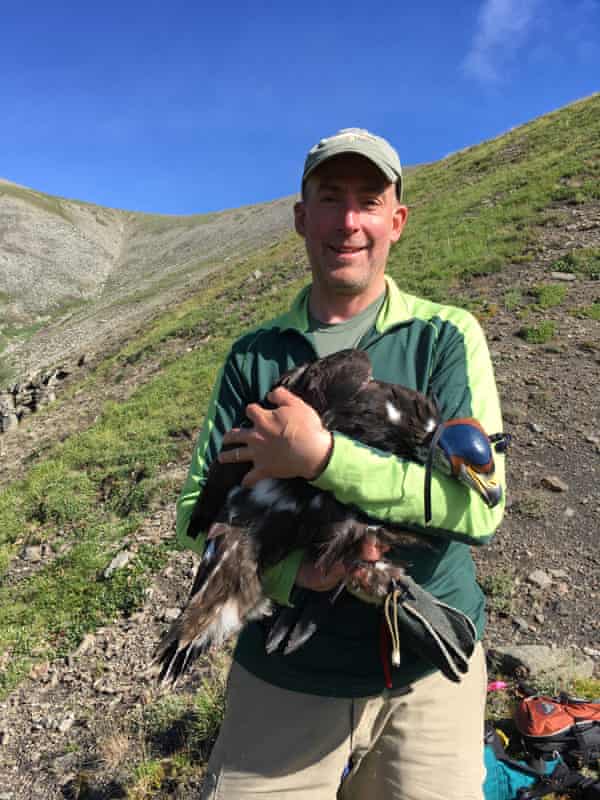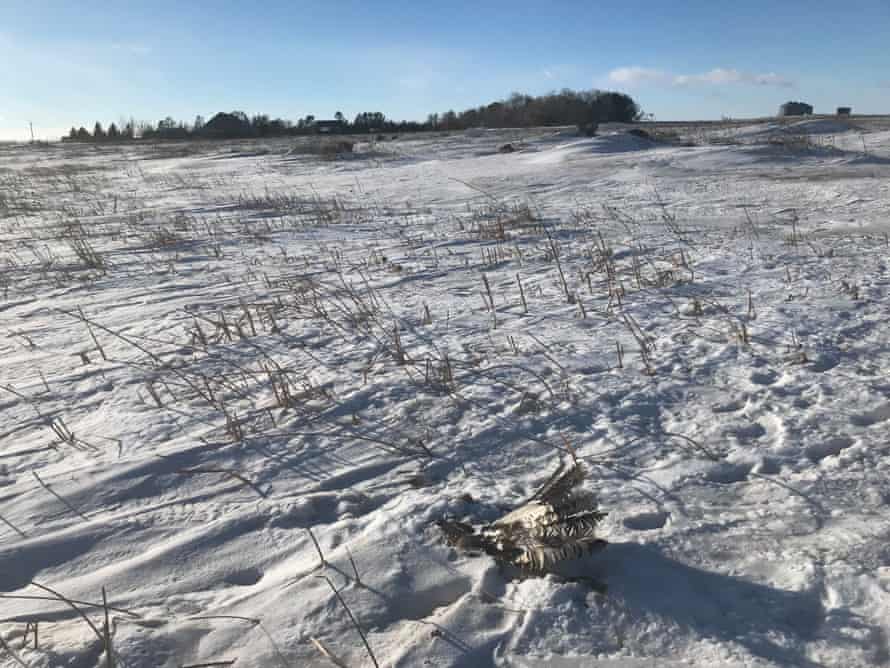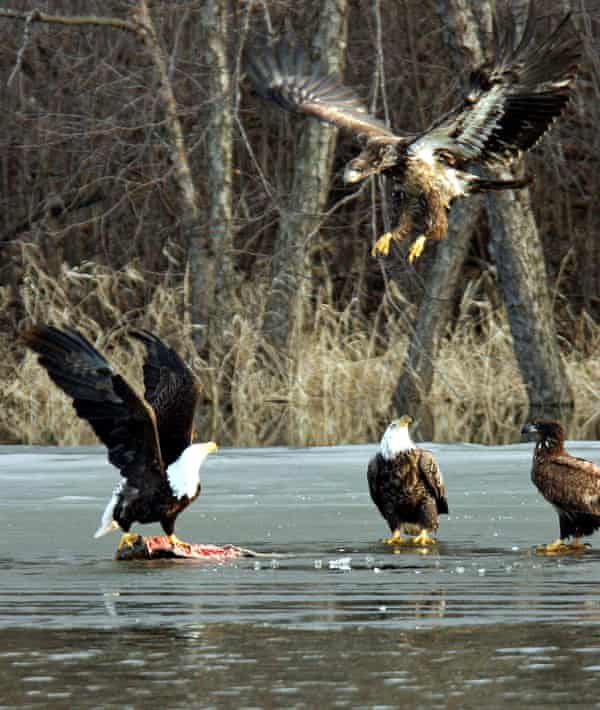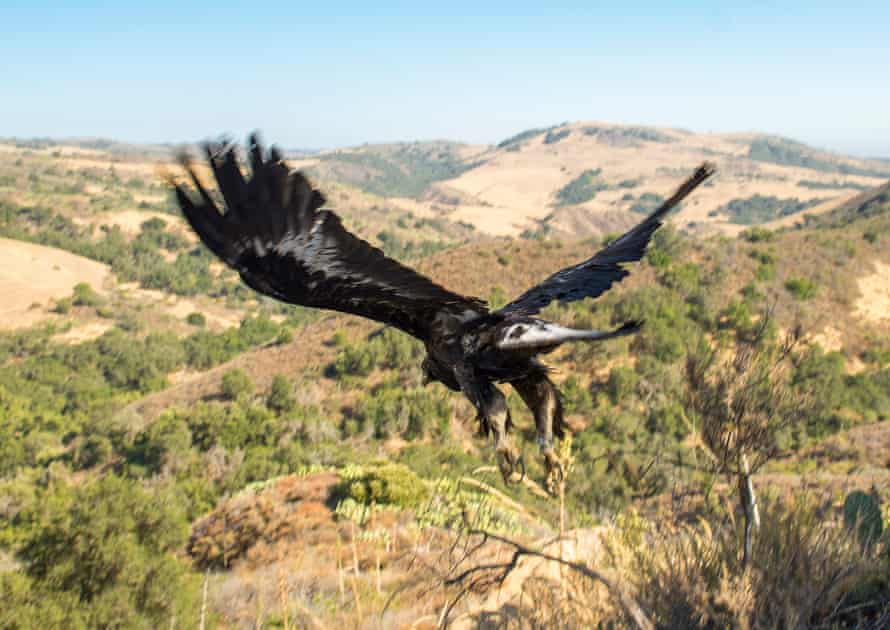What Happens When a Baby Eagle Dies in the Nest
O ne morning toward the end of January 2019, Steve Lewis, a US Fish and Wildlife Service (FWS) biologist in Juneau, Alaska, logged on to the website Movebank.org to check the whereabouts of some golden eagles that he had tagged with GPS trackers.
Lewis, a lanky, outdoorsy 49-year-old, usually tried to look at the location data once a week, but he had spent most of the month at home on furlough, unable to work as a result of the government shutdown. Eager to catch up with his birds, Lewis beelined it to his office when he got back to work. "The first thing I did," he says, "was go and check on my eagle tags."
One bird in particular, Golden Eagle 1703, gave him pause. Lewis knew the animal well. He had tagged it on 26 July 2017, when it was still a nestling on a rocky outcrop in Denali national park and preserve. Even before it knew how to fly, 1703 displayed its might by leaping from its nest and gliding a quarter mile down a valley to evade Lewis's initial attempt at tagging it. After a short hike, Lewis and his team retrieved the squawking bundle of black and white feathers, outfitted it with the tracking device, and returned it safely to its nest.
In the 18 months that followed, 1703 flourished. The bird traversed about 8,000 miles, from Denali to Wyoming, all the way back up to Alaska's North Slope, where it probably feasted on waterfowl and perhaps a straggling caribou calve of two. From there, it carved a long, treacherous path south through the wilderness of western Canada and worked its way back to the lower 48 to hunker down for its second winter on Earth.

Little is known about what golden eagles do in the liminal years between leaving their parents' nest and settling down to build a nest of their own. Each ping from 1703's solar-powered GPS revealed a tiny part of the picture, offering a rare glimpse of an apex predator as it learned the ropes of the natural world. "It takes four or five years for them to reach maturity," Lewis says, "and it's unknown how long it actually takes them to then compete and get into the breeding population. So you have to follow a bird for years."
But now, staring at his computer screen on that January morning, Lewis could see that 1703's location device was stationary in Sully county, South Dakota, and had been so for two days. "It was seeing the sun and talking to the satellites," Lewis says, "but it wasn't moving."
It's not uncommon for Lewis to lose a bird. Since 2014, he, along with colleagues from the National Park Service and the US Geological Survey, have tagged 49 golden eagles in Alaska as part of a broader effort to understand their biology, behavior and population trends. Of those birds, only 17 are still being monitored. Sometimes the GPS device malfunctions or the eagle shakes free from it. Other times the bird dies.
"It's a tough world out there," Lewis tells me, "especially for eagles." They can starve to death or get electrocuted by high wires or be decapitated by wind turbines. None of those fates, however, seemed likely in the rolling farmland of Sully county.
Hoping to get a sense of what went wrong, Lewis opened a souped-up version of Google Earth, plugged in the last GPS coordinates he had for 1703, and began looking around the virtual landscape. There was a nearby road, a line of trees, acres of empty land, and what looked to be a farmhouse. "It definitely felt suspicious," Lewis says.
He called up a Fish and Wildlife office in Pierre, South Dakota, and asked if anyone could go check on a downed eagle tag.
R ichard Bare wasn't sure whether to be pissed off or deeply disappointed by the prospect of having to retrieve yet another dead eagle. "I first and foremost suspected a shooting because we were having a rash of eagle shootings," says Bare, a special agent with FWS's office of law enforcement, who was stationed in South Dakota at the time. In the five weeks leading up to 1703's death, he had responded to a bald eagle shooting and two separate golden eagle shootings. None of the birds survived, and he found no evidence to suggest the incidents were related. The case of 1703 seemed like more of the same.
While the average American might be shocked to learn of an eagle being intentionally blasted from the sky, those who work in wildlife law enforcement know it's an alarmingly common problem. According to one FWS report, somewhere in the range of 1,000 golden eagles are shot each year. Sometimes it's poachers who want to sell the bird's feathers on the black market, other times it's ranchers who want to keep the dive-bombing predators from snatching their livestock.
Bare, who has been a special agent since 2016 and before that spent close to a decade in the field as an FWS game warden (the outdoor world's equivalent of a beat cop) ballparks that over the course of his career he's dealt with upwards of 200 cases involving eagles – shootings, poisonings, collisions with cars, starvations. "If you asked me about any other eagle, I probably wouldn't remember it," he says. But 1703 "was a flashbulb event" because the weather was memorably miserable, even by South Dakota standards. A punishing cold snap had plunged temperatures well below zero while sustained winds of 50mph ripped across the plains.
After a quick chat with Lewis, Bare loaded his cold-weather gear into his truck and hit the road. 1703's GPS tracker was pinging about five miles north-west of where the Oahe Dam cuts across the Missouri River to form Lake Oahe, one of the nation's largest man-made reservoirs and fertile hunting ground for birds of prey.
When Bare arrived at the location, he saw all the same features that had popped up on Lewis's computer screen – the quiet country road, the shelter belt of trees and the farmhouse, which in real life was dilapidated and long ago abandoned. A firm layer of snow crunched under his boots as he walked across the field, scanning the ground for any signs of an eagle or an errant GPS tag. Then, among the knee-high wheat reeds that poked through the frozen landscape, Bare spotted what looked to be a clump of tail feathers. He took out his camera and began documenting everything. "Even though something might not be a criminal investigation, I have to treat it as such and maintain the integrity of the evidence," he says, "the evidence being the eagle in this case."

Only two species of eagles are native to the US – the bald eagle and the golden eagle – and few animals in the world enjoy as many legal protections as they do. In addition to the Migratory Bird Treaty Act and the Lacy Act, which regulates the trade of wildlife, they are privy to the Bald and Golden Eagle Protection Act, a federal statute that threatens steep fines and jail time for anyone caught killing eagles, disrupting their nests, or generally interfering with the birds.
Passed in 1940, the law was originally designed to protect only bald eagles. At the time, the species was teetering on the edge of extinction in the contiguous US as a result of hunting, habitat loss and the toxic effects of DDT. In 1962, Congress amended the act to include golden eagles. Nearly 50 years later, the Bald and Golden Eagle Protection Act has proven to be a godsend, at least for bald eagles. The national bird is widely considered one of the 20th century's greatest environmental comeback stories: in 1963, a mere 417 nesting pairs lived in the lower 48. Today well over 10,000 pairs can be found from the suburbs of Boston to garbage dumps near Seattle.
Golden eagles haven't been as lucky. While they are not classified as an endangered or threatened species, they certainly aren't thriving. FWS estimates that in 1967, there were 31,813 golden eagles in the US. In 2014, the most recent year for which data is available, the agency estimated there were 31,477 golden eagles in our skies. It's a remarkable stretch of stability, but it's unclear if the numbers can hold as wind farms rise across the western US and myriad pressures from habitat loss, environmental degradation and the climate crisis push down on raptors and the animals they prey upon.
With so many threats looming, Bare knows as well as anyone that the last thing golden eagles need are people shooting them out of the sky. After a few minutes of photographing the area, he dug 1703's frozen carcass out from under the snow and gave it a once over in the wind-whipped field. Much to his surprise, there were no overt signs of trauma – no bloody bullet hole or broken wing or spilled guts. The bird weighed more than 7lb and, aside from being dead, looked to be in good shape. Still, there was no telling what type of damage might be lurking under its plumage. Bare zipped 1703 into a small body bag and chewed over the possibilities on his drive back to the office.
A day or two later, a preliminary X-ray seemed to support his original hunch when it revealed two metal fragments near one of 1703's wings. "It resembled the approximate diameter of buckshot," Bare says. Following protocol, he packed 1703 on ice and FedExed it to the National Fish & Wildlife Forensics Laboratory in Ashland, Oregon.
Like that, 1703 had gone from a high-flying predator to commercial cargo.
O n any given day, a menagerie of dead animals passes through the FWS's forensics lab. From the outside, the building looks like most any other government facility – squat, gray, plenty of parking. Inside, it's filled with sophisticated laboratory equipment and staffed by a small, exquisitely specialized team of scientists whose disciplines range from herpetology to ornithology to ballistics to genetics. When it comes to analyzing evidence of animal-related crimes and building scientifically sound prosecutions against wildlife traffickers, poachers and others who inflict harm on nature's inhabitants, there is no better place on earth.

Like any potential murder victim, 1703 underwent a full postmortem in hopes of pinpointing the cause of death. That task fell to Rebecca Kagan, one of two staff pathologists at the lab. If there's a federally protected animal that dies under mysterious circumstances, there's a decent chance it will end up on Kagan's exam table. One day it's an endangered Mexican gray wolf; the next day an eagle.
"We get a lot of bald and golden eagles," Kagan laments. In 2019, she and the other pathologist at the lab necropsied about 100 eagles total, including 1703. Managing an endless stream of suspiciously dead animals can be bleak. But Kagan keeps a sharp sense of humor – she jokes that she always carves the bird at Thanksgiving – and finds comfort in knowing that her work is ultimately in service of conservation. Sometimes a necropsy yields evidence that helps finger the bad guy. Other times her efforts reveal that there wasn't any foul play, just the lethal hand of Mother Nature at work.
Kagan unpacked 1703 on 13 February 2019, roughly three weeks after Lewis first noticed its GPS at a standstill. Dribs of a red-brown fluid leaked from the bird's mouth when she tilted its carcass. She checked the esophagus and it was empty. She checked the crop, a pouch-like structure near the upper part of the digestive tract, and found a 3.5oz blob of partially masticated muscle and fat mixed with a few white hairs that looked like they came from a deer. "The nutritional condition was good," Kagan recalls. "This bird didn't starve to death."
Slowly and methodically, she worked 1703 over, inspecting and documenting every inch of its insides and outsides. A large amount of "watery, red-tinged" excrement pooled in its cloaca and its gall bladder contained "scant, yellow-green, watery bile", according to the necropsy report.
Kagan eventually arrived at the two metal pellets that showed up on the preliminary X-ray only to discover that they were nothing more than tiny remnants from the GPS harness. Hours spent deconstructing 1703, and the cause of death wasn't any clearer. "It's a little frustrating," she tells me. "We really checked everything with this bird."
As a final step, she shipped 1703's liver to Michigan State University for a detailed toxicology analysis. A few weeks later the results came back positive for bromadiolone, better known as rat poison.
Even if you've never heard of bromadiolone or its chemical counterparts –brodifacoum difenacoum and difethialone – chances are you've been in close proximity to them. They are known as "second-generation anticoagulant rodenticides", a popular class of poisons that essentially kills a rodent by making it bleed to death from the inside out. Exterminators stuff these poisons in those black plastic bait boxes that you see everywhere in cities – down alleys, on the sides of restaurants, in condo buildings' parking lots – and they are deployed throughout the agricultural sector to keep germ-carrying rodents away from food supplies.

These poisons came to prominence in the late 1970s and early 1980s and were "extremely widely embraced" from the get-go, says Bobby Corrigan, an esteemed rodentologist who has spent his career studying and consulting on pest control practices. "It was kind of a magic bullet of advanced chemistry."
Corrigan frequently preaches the importance of addressing the root causes of rodent infestations – improving trash storage and collection, addressing degrading infrastructure – and is unsettled by the widespread reliance on second-generation anticoagulants and lax enforcement efforts by the Environmental Protection Agency to restrict their use. But – and this is an important, he says – the sad truth is that we are dependent on these poisons. Forgoing them entirely would lead to an explosion in rodent populations that could usher in "a public health catastrophe".
One reason these poisons are so effective is because, in most cases, the rat or ground squirrel or vole or whatever the target vermin happens to be only needs to eat a single dose. The poison works quickly, and the critter typically doesn't have time to excrete any of the poison before it keels over. In other words, a rat that dies from a second-generation anticoagulant often dies with a belly fully of poison. And if a scavenger comes along and plucks up the rodent corpse, it, too, will be exposed to the poison. It's a process that scientists call bioaccumulation, and it occurs all the way up the food chain.
Just like mercury in the ocean, these rat poisons have seeped into ecosystems far and wide. A 2018 study from the California department of pesticide regulation found detectable levels of second-generation anticoagulants in roughly 85% of mountain lions, bobcats and Pacific fishers that were examined. Birds of prey, including eagles, are especially at risk for these types of "non-target animal" exposures. Maureen Murray of the Cummings school of veterinary medicine at Tufts University analyzed 94 birds of prey from New England and found traces of these poisons in a stunning 96% of them. "We can say confidently that there's widespread exposure," Murray says. "But how that translates into mortality or deaths is still very much an unanswered question."
The toxicology report for 1703 showed that it had 0.05 parts per million of bromadiolone in its liver. Murray says it's unlikely that's enough to directly kill an eagle, but there's not really any good data on what the lethal threshold is for a bird of that size. If the poison didn't deal the fatal blow, I ask, could it have impaired 1703 in a way that made the bird less capable of hunting or migrating or withstanding the winter and thus contributing to its death? Again, Murray says, it's an important question to which there's no answer. And even worse, it's becoming an increasingly difficult question to study because, Murray explains, so many raptors in the wild now have rodenticide in them that it's almost impossible to find enough birds that are free of rat poison to serve as a control group.

Because of all the uncertainty around how the poisons affect birds, Kagan listed the final cause of death on 1703's necropsy report as "undetermined (suspect poison)". It's a fate that many golden eagles suffer. While data is scarce, FWS scientists estimate that poisonings are now the leading cause of anthropogenic-induced death among golden eagles, possibly killing as many as 2,000 a year.
Kagan's exam table was the end of the line for 1703. Sometimes an eagle can be sent to the National Eagle Repository, which distributes deceased eagles to Native American tribes so they can use the animals for ceremonial purposes. 1703 would not find any such greater meaning in death, however, because the eagle repository, according to an FWS spokesperson, cannot distribute eagles exposed to rodenticides.
On 7 March 2019, Kagan filed the official necropsy report and moved on to the next animal carcass in her queue.
Without any evidence of a clearcut crime and an ever-expanding caseload, Bare closed the file on 1703 and retrained his focus on the spate of eagle shootings.
And out in Juneau, Lewis logged 1703's data and carried on monitoring the 17 other golden eagles that are still tagged and up in the air, hoping they avoid the wind turbines and high-voltage wires and blasts of buckshot and poisoned prey that have made the natural world so unnaturally dangerous for the species.
"I know that death is a reality," Lewis says, "but it's really frustrating when it seems like it's a senseless death."
-
This article was amended on 10 April 2020 to correct the name of the National Eagle Repository.
What Happens When a Baby Eagle Dies in the Nest
Source: https://www.theguardian.com/world/2020/apr/01/golden-eagles-us-dying-why
0 Response to "What Happens When a Baby Eagle Dies in the Nest"
Post a Comment